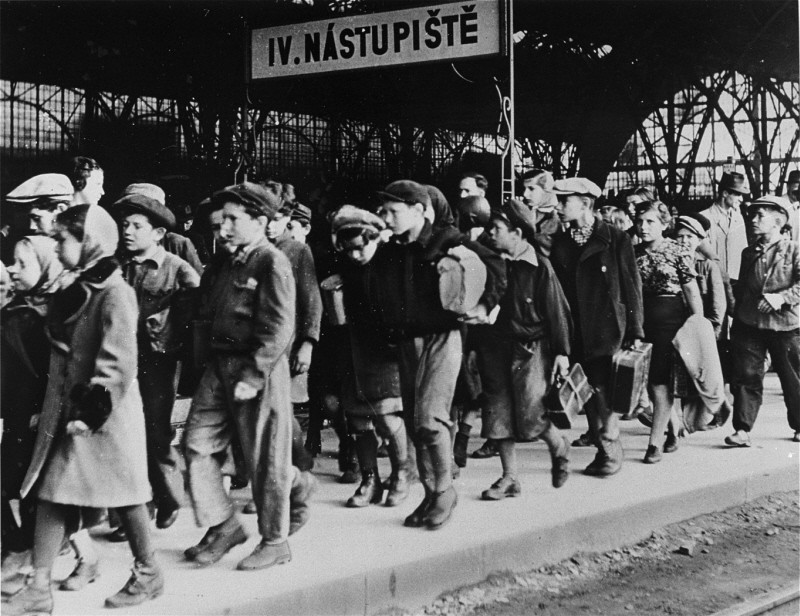
Displaced Persons: Administration
Background
Even in the midst of the war years, the Allied powers anticipated that a refugee crisis would follow the defeat of Nazi Germany. As early as 1943, Allied forces began drafting plans to meet the challenge of liberating, rehabilitating, and repatriating the millions of displaced persons (DPs) who would come under Allied control. Expecting that DPs would want to return quickly to their native lands, the American, British, Soviet, and French allies designated their armies (each of which occupied a sector of Germany, and Austria) as the immediate providers of relief to the refugees.
The colossal relief effort was expected to take no longer than six months. Between May and December 1945, the military, along with civilian rescue teams of the United Nations Relief and Rehabilitation Administration (UNRRA), successfully repatriated more than six million DPs. But the army was ill-prepared to handle the one million DPs, mostly from eastern Europe and including 50,000 Jews, who refused to return to the lands where their families had been massacred and where antisemitism still ran rampant. The Jewish DPs (known as the Sh'erit ha-Pletah—the "Surviving Remnant") became long-term wards of UNRRA and the occupying forces, especially the American and British armies. The often harsh treatment of these displaced persons between April and August 1945 blighted the record of the United States and Britain in the months following liberation.
From Military Rule to Internal Autonomy
Three days after the liberation of Bergen-Belsen, Josef Rosensaft was elected head of the first Jewish DP committee. Similar committees were set up in other DP camps. However, relations between the Jewish DPs and the Allied military authorities soon became strained. Curfews were imposed and the DPs were given limited rations. Many had to wear concentration camp uniforms and they were often housed in camps with non-Jewish Poles and other Europeans, sometimes even with Nazi collaborators.
American Jewish army chaplains served as representatives of the Jewish displaced persons in the first few months by carrying mail and requests for them. Still, relations between Jewish DPs and the army deteriorated to the point that the Department of State arranged for Earl G. Harrison—dean of the University of Pennsylvania Law School and American envoy to the Inter-Governmental Committee on Refugees—to survey the DP camps. In August 1945, Harrison recommended that the Jews be recognized as a distinct nationality, housed in exclusively Jewish camps, and aided in their eventual emigration from Germany. Under the guidance of President Truman, General Dwight D. Eisenhower responded swiftly to the recommendations. By late 1945, camp operations were administered entirely by UNRRA and other voluntary agencies, most notably the American Jewish Joint Distribution Committee. Early in 1946 those agencies and the Allied armies recognized a new de facto authority—the organized Jewish DPs themselves.
In February 1946, a Congress of the Sh'erit ha-Pletah elected the Central Committee of Liberated Jews in the American zone. Zalman Grinberg and Samuel Gringauz became its official representatives. Similarly, in September 1945 in Bergen-Belsen, Josef Rosensaft became the recognized representative in the British zone. With the Americans allowing Jews fleeing Poland to enter the American zone, the UNRRA and JDC providing supplies to the DP camps, and a Jewish Committee managing each camp, the Sh'erit ha-Pletah prepared to enter a brief period of autonomy.
Establishing a Jewish Society
By mid-1947, the number of Jewish DPs in Germany, Austria, and Italy had reached 250,000. This number included 150,000 Polish Jewish survivors, repatriated from the Soviet Union, who fled eastern Europe after the Kielce pogrom in Poland on July 4, 1946. This pogrom claimed 42 Jewish lives. Widespread anti-Jewish violence in southern Poland convinced many survivors that they could not return to their prewar homes.
The Central Committees of the American and British zones established working societies in the DP camps with the aid of UNRRA, from 1948, with its successor agency (the International Refugee Organization; IRO), and with Jewish relief organizations like the JDC and its British counterpart the Jewish Relief Unit (JRU). They created services that helped survivors trace their relatives, gather religious and educational supplies, and attend cultural and athletic events. The Organization for Rehabilitation through Training (ORT) trained Jews to enter the workforce. The leaders of the Central Committees served as recognized representatives for the Jewish DPs to the Allied authorities.
Eventually, members of the Sh'erit ha-Pletah began to protest their extended stay in DP camps and to denounce the British for refusing both to recognize Jews as a distinct nationality and to open immigration to Palestine. In late 1945, President Truman ordered that preference be given to the DPs with regard to restrictive US immigration quotas. Under this Truman directive, 16,000 Jewish DPs entered the US. In 1948 and again in 1950, Congress passed laws allowing more open immigration for refugees to America.
With the passage of the 1948 and 1950 DP Acts and the establishment of the state of Israel in 1948, the Jewish DPs left Europe en masse and settled predominantly in Israel and the United States. The Central Committees dissolved in 1951, and by 1952 all but one DP camp had closed.
Critical Thinking Questions
- What challenges did survivors face in the DP camps?
- What challenges did the Allies face in establishing and supervising DP camps?
- What responsibilities do (or should) other nations have regarding refugees from war and genocide?